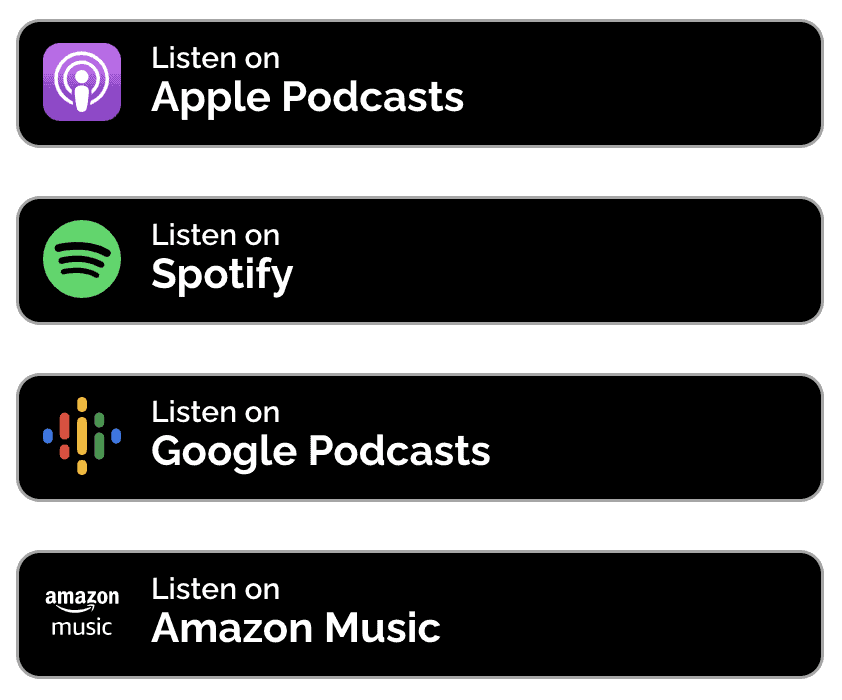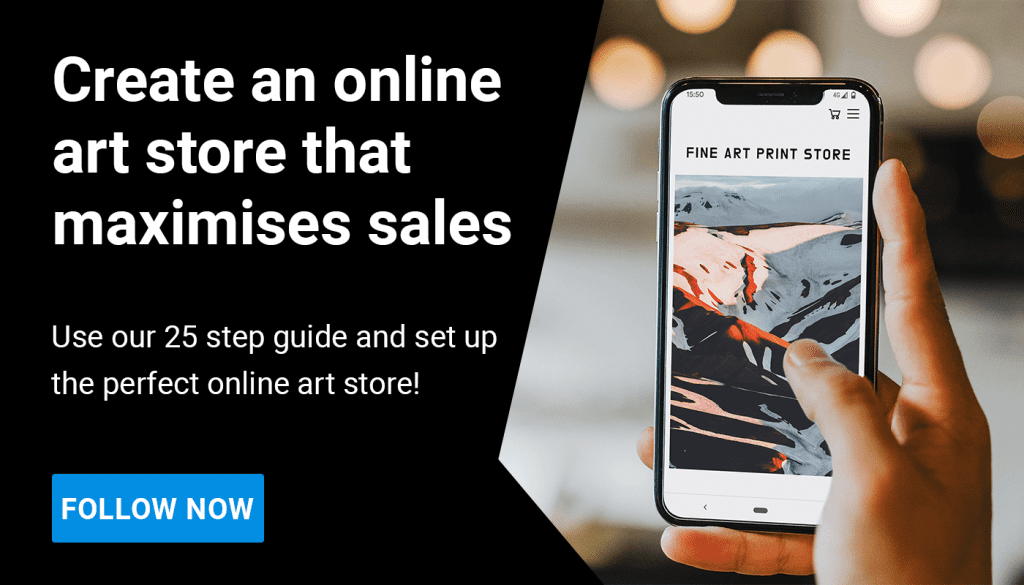Listen to this episode with Ian wherever you get your podcasts:
Ian Lauer is a highly accomplished and renowned astrophotographer. He is also a deep thinker on the subjects of marketing, social media, and art print sales, which has helped him to turn his passion for astrophotography into a full time career.
Stuart Waplington, founder of theprintspace, spoke with Ian for episode 1 of our new podcast series, Sell Out. We have known Ian for a little while now, yet his tactics for selling art online blow us away time and again! Ian is a master of the ‘timed print sale’, meaning he does a few print sales a year where the prints are available for a limited period of time. They are exclusive and buzzing with energy.
In this episode, we get the inside tips on how to plan and execute a timed sale; how to build hype, keep the momentum up on your social channels and turn your customers into repeat buyers. Expect a master class on marketing art print sales!
It was a fascinating talk helped by the fact that Ian is an incredibly inspiring speaker. Listen to the podcast above or scroll down for the transcript.

Key Takeaways
7:10 – Ian’s ‘why’
“I wanna convey that feeling of just the immense beauty of the universe. I wanna put you in that spot. So with my photos I want to represent that, to put you in that position of being there under the night sky feeling how incredibly beautiful and awesome the universe and the night sky is. For me, that was such a life changing moment and I wanna be able to share that with people and so I really try to do that with my Milky Way photos.”
14:54 – Deciding what prints to sell
“I kind of do an 80-20 rule where it’s like 80% I’ll look at the numbers and be like what was the most popular and then I’ll start to trend towards that. But then there is the other 20% that I reserve for gut feeling.”
29:06 – Why people buy your art online
“Somebody needs to see your work 25-30 times before they decide to make a purchase.”
“Constantly showing people really gets them, who would have never bought before, to become interested in what you’re doing and they see it so many times with the story that you have told, that they are interested in buying now.”
31:02 – People connect with who you are
“The more you can show yourself or show how excited you are or how much you love your stuff, they will connect with you, the artist, and they will purchase your art because they have made that connection with you. They connect with your art but really they are connecting with what you are saying about the art.”
53:39 – Your email list brings the most repeat buyers
“More than 50% of my email list are repeat buyers. I did not expect it. I just knew that email lists are very powerful and they’re a way to get around the social media algorithm so anything I wanted to communicate, I could send an email to my email list.”
58:40 – Why your social media presence is so valuable
“Don’t look at your number of followers as a demotivator for success. Don’t think I only have 10 people on my mailing list. Imagine you are in a room with those 10 and you can communicate directly with them. Next time you gather it’s 20, then 100. That’s quite a lot of people, right?”
“So it’s not about how many followers you have, it’s what you do with your audience that counts. Truly engage, create those connections and remember, we all start from zero.”
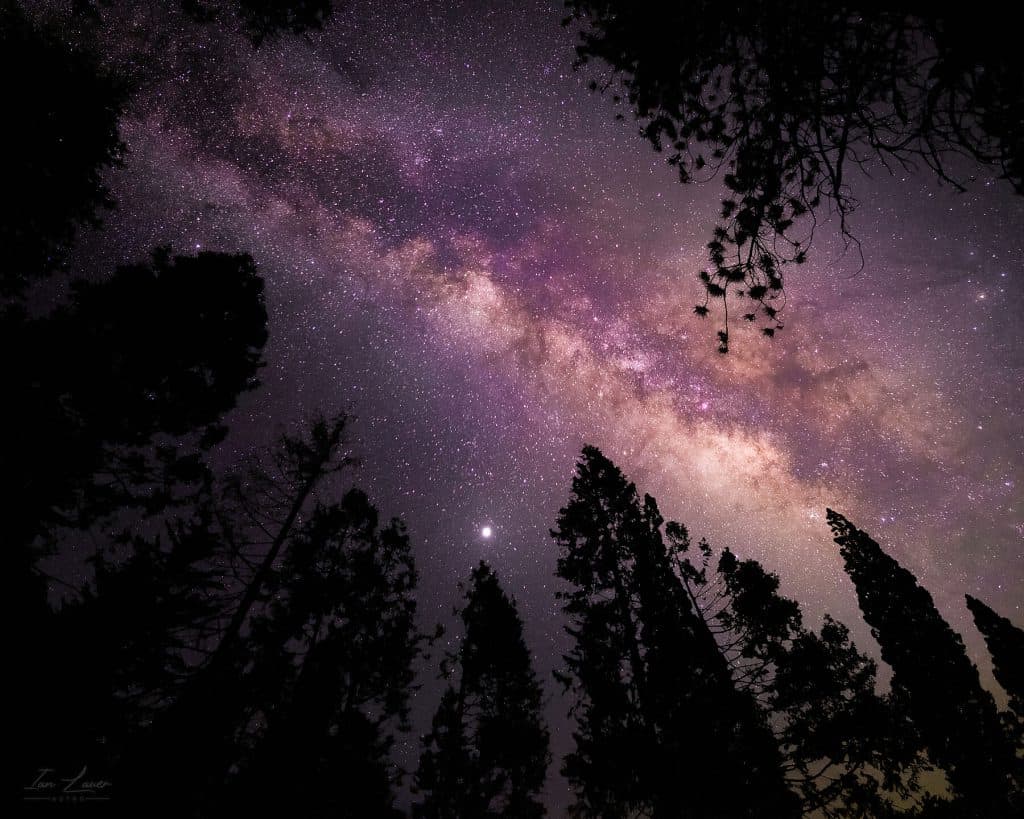
Transcript
Stuart: Ian, I’d like to start by asking you to give us a little history on how you came to be an astrophotographer?
Ian: Oh yeah, definitely! Well, probably like most people as a kid you have some kind of a general interest in outer space, whether it’s the planets or the big scientific terms like black holes. I actually never really got into astronomy until after I went to high school, and it’s actually pretty funny because when I was in high school I took a photography class and I failed it which is hilarious now because I am a photographer. But in that class I wasn’t paying attention, I wasn’t very focussed. I was more focussed on playing American football for my high school and things like that. I remember the very last day of class, the teacher was telling me I was failing and I was like, oh my gosh, I can’t fail this class, I have to pass! So I begged the teacher, saying I will do anything to pass this class, literally anything. She kind of sat there for a minute and thought about it. She looked at me, handed me a sponge and told me to go scrub the dark room. So I spent 2 hours cleaning every inch of that dark room. When I got my report card, I got a C- and I was like ah, yes, perfect!
So I thought that was the end of my photography career and never picked up a camera for probably 15 years. But anyways, I went to university and studied astrophysics because I was just super interested in space and I loved the feeling of being under the night sky and stars. I would watch a lot of documentaries on television where they would have those cool time-lapses of you know, the stars moving behind the observatories and things like that. I thought it was so cool. Astrophysics, while it was very challenging, it was awesome learning about space and the physics behind it. It still did not satisfy that creative side and I realised that I loved being at the telescope more than I did doing research
When I graduated college I went on to work in the telescope industry and that’s when I realised that it wasn’t the Hubble telescope or these million dollar observatories that were taking these amazing images of deep space, it was just people like you and I with the right equipment and with the right ways to process images. They were taking these incredible images of deep space, of nebulas, of galaxies. So that was my entry into astrophotography, the deep space aspect of it.
As I got more into photographing deep space, galaxies, star clusters and things like that, I realised that I really loved the Milky Way photography stuff and the night-scape photography! After doing deep space where you have these huge telescopes and big astronomical cameras and filters and massive telescope mounts that track the stars and objects as they move across the night sky, I scaled down and got a Fujifilm camera. It was so different from what I was used to. It was just a Fujifilm camera, a tripod and a wide lens and all you do is take a 20 second photo and boom! You got a photo of the Milky Way. I was like woah, it’s this easy? I can’t believe this!
I started hiking out into the wilderness, doing the whole adventure photographer thing and going out, finding places to best shoot the Milky Way. Doing what we call chasing the Milky Way, you know, getting the best weather, best conditions, best foregrounds for these blue hour blends or just single shot Milky Way photos. I kind of took the untraditional path – most people start with photography, shooting the Milky Way, and then they might make their way up to shooting deep space with a tracker or something like that. I went the opposite direction. I had the big huge observatory level equipment and I started getting smaller and smaller gear until I ended up with a Fujifilm camera and shooting the Milky Way. Here I am today, shooting the Milky Way all the time and I still do deep space. I just love it all man.
Stuart: From the creative side, is it the framing of the Milky Way around the natural world that interests you?
Ian: I try to convey the feeling of being in that moment under the night sky because what really drew me into astronomy, to begin with, was a trip out to Death Valley National Park in California. I was 19 years old. I believe that was the first time I saw the night sky in a truly dark space. I mean it’s an overwhelming amount of stars. Since then I have always tried to capture that same feeling through these Milky Way photos of what it is like to feel that. I wanna convey that feeling of just the immense beauty of the universe. I wanna put you in that spot. So with my photos, I want to represent that, to put you in that position of being there under the night sky feeling how incredibly beautiful and awesome the universe and the night sky is. For me, that was such a life changing moment and I wanna be able to share that with people and so I really try to do that with my Milky Way photos.
Stuart: In terms of selling prints, do you give people that sense of being under the night sky so that they may select a bigger print? To get that immersive feeling?
Ian: Yeah, that’s a good question. Really what I did was I looked at what are some common frame sizes that you can purchase and I just selected three, really no rhyme or reason, other than some people would want something smaller because they have a small space, and some people want a standard like 16×20 inch print to get that bit bigger feeling but not taking up the whole wall. And then I do the large size for the people who just want that huge image of the Milky Way or nebula or galaxy on their wall or something like that. So I selected 3 options to give people a choice, but it’s not too many options so they do not get overwhelmed.
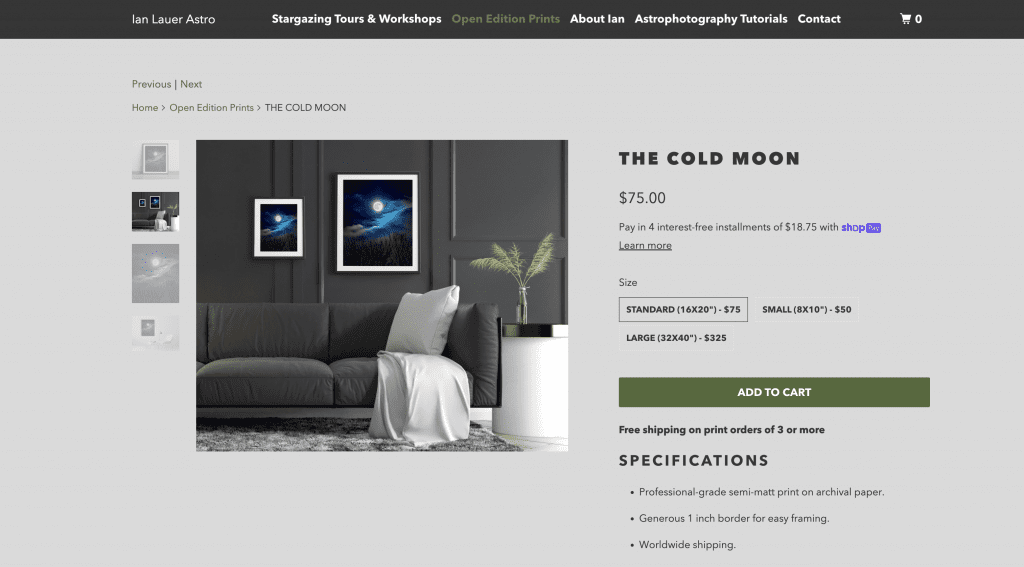
Sometimes if there are too many options people kind of forget that they wanted it because they are too focussed on picking the right size. They leave the measurements for later and then forget about it. Versus if you just give them the three options it makes it easier for them to select a size. And that was really the idea behind the sizes that I chose. Make it easy for someone to make a decision to purchase.
Stuart: When did you first realise that you wanted to start selling prints of your work?
Ian: Honestly it was social media. I was never a big social media person but I was encouraged to start posting my work and become more active on social media from my partner, Cat Machin. She was like, I guarantee you people wanna see it. So I became more active on social media, almost doing the whole ‘I’m an influencer’ kind of thing, posting all the time, giving people updates on where I am etc. People were actually interested in what it’s like to go out and take these kinds of photos. So I brought those people on the journey and every time I would post a result as a photo or a TikTok video, or post something on Twitter, I would get loads of people asking me like hey do you sell prints? Is this a print? Where can I buy this?
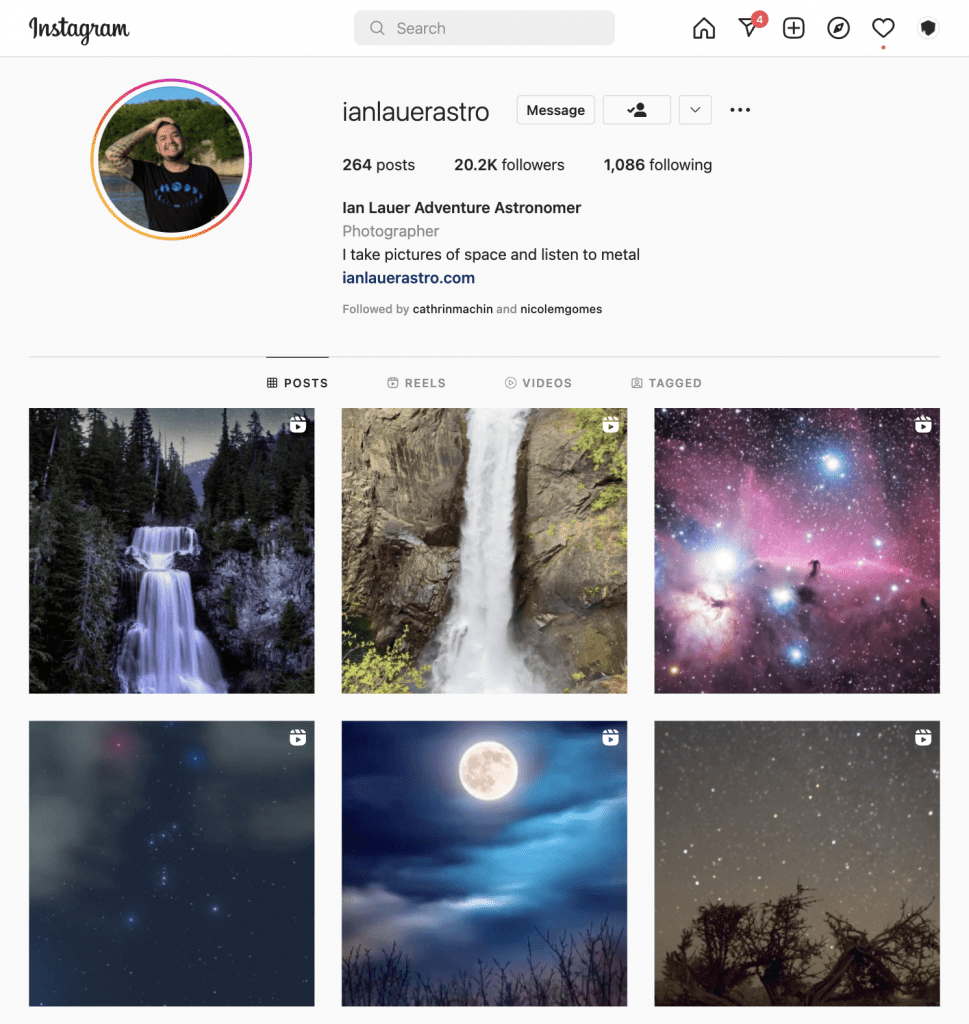
That started to plant the seed in my mind that people want this stuff and people want the universe and the stars in their homes. The biggest connection for me was that it’s not just the people who want this cool print in their house, it’s that they are missing the stars in their life and these prints, these images of space bring the stars back in their lives. A lot of people, most of the human population, live in light pollution and so they can’t see the stars as I saw them when I was 19 yrs old out in Death Valley. I wanted to bring that to them and be able to convey that message and say that these prints bring those stars back into your lives. That really connected with people and just gave them another push to be like I do want the stars in my life, I don’t get to see them everyday. That kind of messaging helped me in getting more and more people interested in wanting these prints.
Stuart: On social media you can reach a wide range of people. Do you find that these are people from the astronomy community or are these people who discovered you through the algorithm?
Ian: I would say it’s a good mix of both. A lot of astronomy people, they are just astronomy fans. They like space, or they like sci-fi, they are Star Wars fans or Star Trek or anything sci-fi related. They like reading Dune or playing War Hammer or you know anything sci-fi or anything that has to do with space. And there’s the other half that has never seen this type of photography done before and it resonated with them. Or maybe they love photography and for whatever reason this type of photography resonated with them. There are other photographers who think this is so cool. They love what I am doing and want to support me. So there is a wide range of people that were interested in getting these prints.
Stuart: Do you find that they are requesting a certain type of style or image of yours, or are they receptive when you try to do different stuff and you try to construct the images in a slightly different way?
Ian: Yeah, so obviously I focus mostly on astrophotography but that covers a wide range of types of photography. Within deep space alone there are many different types of photography. You can shoot galaxies, nebulas, star clusters and things like that. There’s linear photography where you just shoot the moon in different ways. And there’s Milky Way photos that you can combine with landscapes and things like that.
When I first started selling, I did these pop-up stores where I only made the prints available for a very short period of time. I always play this game with myself and I guess which one of these prints that I’m selling is gonna be the most popular. Once the print store is over I check Shopify statistics to see which one was the top seller. They all loved the pink deep space photos like the pinks and the blues and the purples and there was like the Orion nebula and people loved that one. Then this other print store that I did it was a Milky Way photo over Haleakala Crater in Maui. I thought that people like the deep space photos so I included a couple more deep space ones in the second store and then all of a sudden it was the Milky Way one that people liked. It’s just hard to really say which one people love so I just play that game. I like guessing and then checking the numbers afterwards.
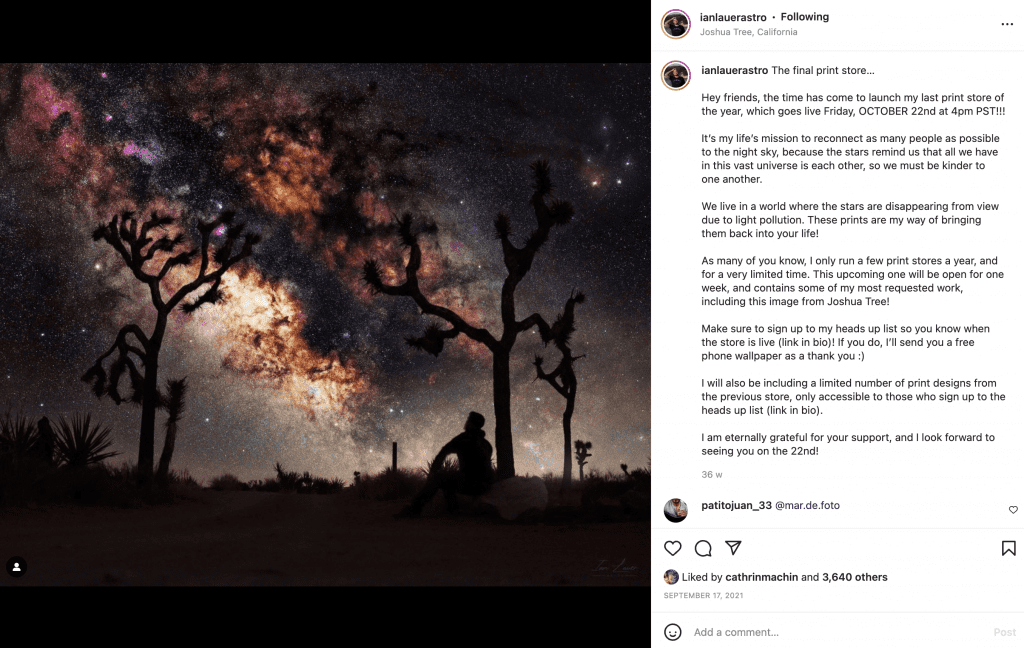
Stuart: Do you get it right generally and does this influence the work you offer for sale?
Ian: I generally try to. I kind of do an 80-20 rule where it’s like 80% I’ll look at the numbers and be like what was the most popular and then I’ll start to trend towards that. But then there is the other 20% that I reserve for gut feeling. Maybe I have an image that doesn’t fit what the numbers are saying but I feel like it will do really well so I throw one in there as well.
Usually I look at the statistics and the numbers to help guide my decisions but I still hold that 20% for just intuition and gut feeling. So I’m not 100% only by the numbers and I’m not 100% only intuition, I tend to be more data-driven and that’s probably the astrophotography or maths side of me but I still want that room for some gut feeling, intuition in there.
Stuart: In general it sounds like the print sales for you just evolved naturally from a passion in what you were doing and following. But how important is it for you to sell prints? What is your motivation for doing it?
Ian: I actually started selling prints because I wanted to pursue astrophotography full time and I didn’t really know any other way than to just sell these prints and see if I can get brand deals and things like that. But I actually left my job back in 2020 to pursue astrophotography full time with the intent of finding some source of income and these print sales will help support my new lifestyle, which is just travelling around taking photos using telescope equipment to photograph the night sky. And so in that very early stage it was extremely important for me to be able to have some success with these print sales and I was honest with the followers that I had. I told them that I’m doing this, I’m taking this leap of faith to see if this works. Your support really helps me bring the stars into your lives and one of the ways that you can support me in doing that is by getting these prints. Every print that you purchase from me helps me to continue to bring all types of content around the stars and the universe and the night sky into your life whether it’s through social media, through talks or through these prints.
What was really important to me was the email list that I gathered because those are the people who want to continue to follow your journey and see what you’re doing.
The print sales eventually evolved into doing workshops because people really wanted to learn how to take these photos. Most of my students from these workshops also have prints of mine. I found that very surprising because they weren’t just photographers. They were people who supported what I was doing. That was such a beautiful thing to see. Talking to them and they are like oh we love what you do and I have like 3 of prints and I bought a camera because of you and now you are doing these workshops and I wanna learn from you. So it’s incredible to see how it evolves from just being, okay I need to sell prints so I can keep doing this and get the support from the community. The people that follow me now are becoming like superfans and it’s amazing. It’s beautiful and I feel very very grateful for that opportunity.
Stuart: You touched on something about honesty. One of the things that comes from talking to a lot of people who have built a social media following and are very engaged in what they are doing, is really putting across an honest picture of themselves, which goes contrary to what the perception is of social media. Would you say that approach is important to build a genuine engaged following?
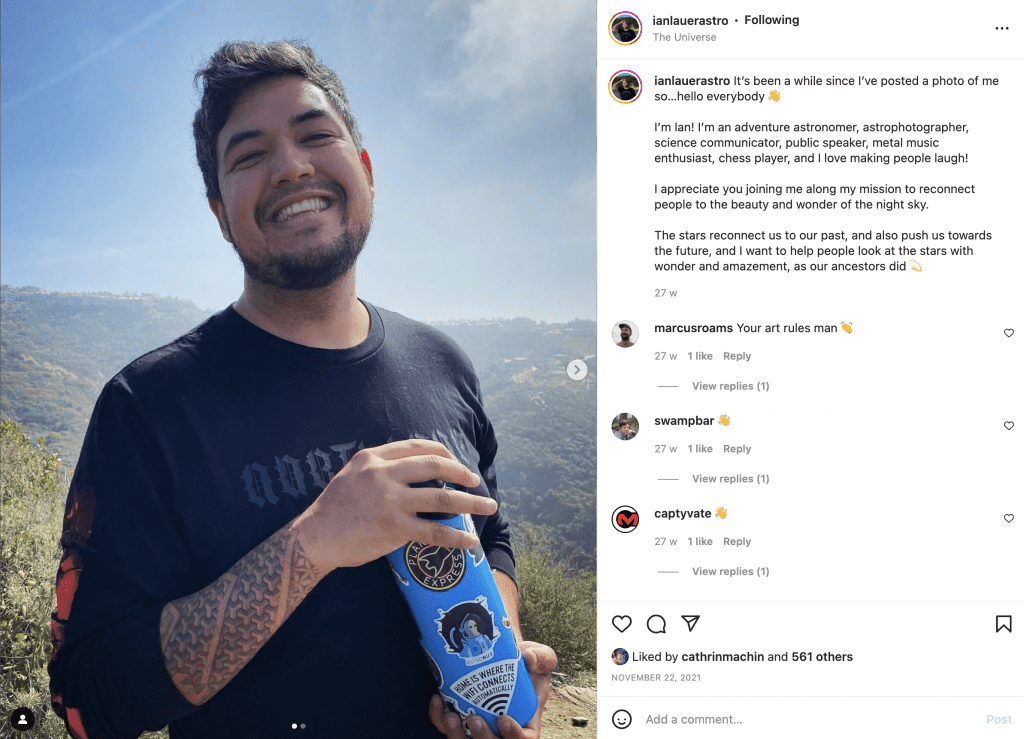
Ian: Of course, you don’t want to be stale. You don’t want to be just another face, a little icon on a social media platform. You want to show people who you are because you will attract the people who like your personality and like what you do. You don’t wanna be this fake person. There is no one else in the world like you so why not use that to your advantage. Be yourself. Your vibe attracts your tribe. The people who like what you do and like who you are and your personality will be drawn to you but they will not be able to find you if you’re not active on social media. The key is just remaining active but also being yourself.
Stuart: Social media has evolved to be a lot more video driven now. Do you feel this has helped make it easier to communicate with your fan base and put across your genuine passion for what you do?
Ian: Yeah, definitely. There are fewer barriers to entry to communicate your passion. What you are doing, going behind the scenes, going live and things like that. But I think also if you’re new, there is this added pressure of like you have to do it all. You have to go live all the time. You have to post constantly or keep engaging with your posts. That can be hard and it can take a toll. I think it should feel natural. For me, I go through phases, like sometimes I’ll take a small break from social media and then I’ll be super active because that’s what works the best for me. There’s still that element that you have to be engaging for your audience.
I think it is very easy nowadays to be able to show people who you are and express your personality. If you are like a brand new person with zero followers on social media, just start. Connect with other people, start commenting on their images, and join communities. Twitter is a huge place right now for photographers, a great place for people who want to meet other photographers and get inspired, great community over there and for people who wanna do Instagram reels and stuff. A lot of people might not like this but it’s a social media platform and as the algorithm changes, you gotta change too, to be able to reach new people. Honestly the ultimate goal is to reach new people who you can present what you have to offer to, and if you gotta make a few changes here and there in order to do that, I would say do it!
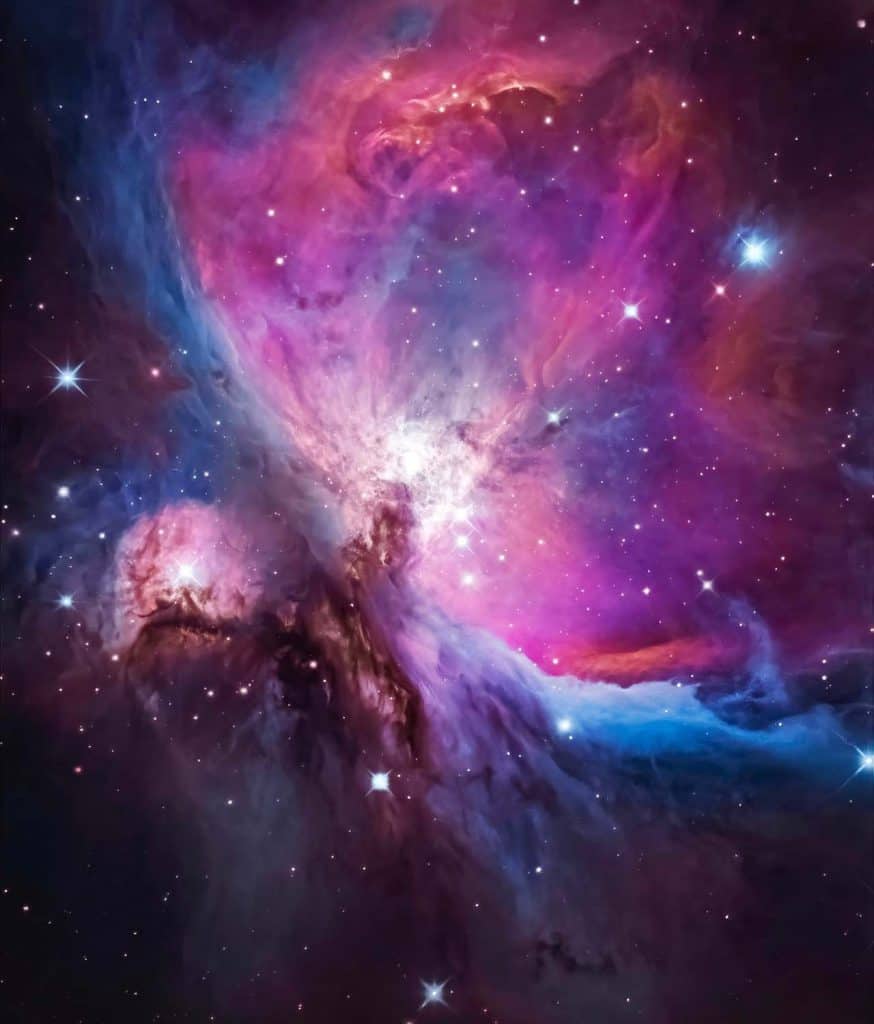
The ultimate goal is to inspire as a photographer, as a creative person whether it’s digital art, photography, painting or anything like that. The goal is to reach new people that you have never reached before because it is such a beautiful feeling when someone says what you’re doing is amazing. The feedback you get is such a satisfying feeling and I think there is too much pressure to get more of that. Just appreciate every single person that comments on your work or who is touched by your work. It’s nice to be appreciated and every time that happens just be grateful because you reached somebody new, you might have changed their life with your work. That is the ultimate compliment.
Stuart: We are very lucky to live in an age where as a creative you can actually find and connect with your own audience. If you go back 20 years, there were always gatekeepers, whether they were the editors of art and creative magazines or curators of galleries, which is quite a small community actually. Within that community there is a consensus of what we like or do not like, what we want to show or do not want to show. I feel like it has been democratised so much just to say I can do what I do and I can put it out there. Any appreciation that you get will mean that you have connected with your audience.
Ian: Definitely. I guess the only gatekeeper is the algorithm of the social media channel. Luckily for me I never came from that art background and I never had to experience having to deal with that but it’s something you hear on your peripheral as to how it’s done. People like what I’m doing and they wanna see more of it so I am gonna continue doing it. I learn from the audience. They tell me what they like, they tell me what they’re interested in and these social media channels help you with their insights and statistics as to what people are gravitating towards. It’s been super helpful to be able to utilise social media in this modern day to your advantage.
Stuart: People on social media can have that freedom to experiment a little bit more about what they put out there because they can put out a range of things and see what people are vibing with and see what they like. In a way your creativity becomes like a two-way conversation. You kind of think of it in the same way as well?
Ian: You can get immediate feedback from your followers and from your fans and that is so powerful because you just immediately know what works and what doesn’t work. If you try something new, you can tell if people don’t like it. The beautiful thing is that you can try something else. That instant feedback is so powerful and being able to directly communicate with the people that like your work. You don’t have to wait to throw a launch or a show and think if people will like this or is it something that people want. You don’t have to wait for that anymore. You know exactly what people are gonna like and not like. That is your strategy for determining what is gonna be successful or not. You know what your audience now enjoys and what they gravitate towards immediately.
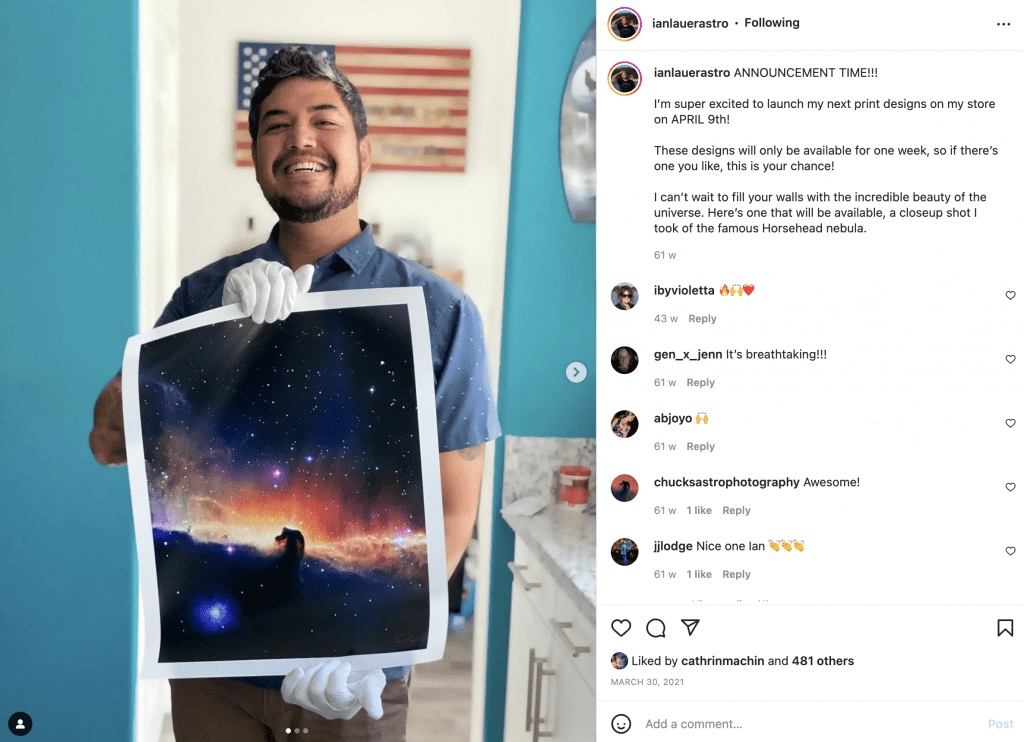
Stuart: I’m often interested in that moment on social media where someone goes from ‘That’s nice’ to ‘I wanna buy a print of that’. What actually causes someone to make that step?
Ian: When I got to the telescope industry, I somehow ended up in marketing and so, that really opened my eyes to what people’s habits are. One of the biggest things that I learnt is that somebody needs to see your work 25-30 times before they decide to make a purchase. That’s why you see many companies have ads in the most random places like billboards.
Let’s take Red Bull, why are they sponsoring sports? It doesn’t make me wanna buy a Red Bull. Then you see the Red Bull car driving around, or the commercials or on a YouTube video. All of a sudden they are hitting you in 25-30 different places and you see the Red Bull at a gas station and you purchase it. Just applying that logic to social media and to creative work – posting your work a lot and when the time comes to it and you have a show or a live event where you are going to sell your prints at, you have got to let the people know that it’s there. You have got to be posting about it constantly, which is almost counterintuitive to what a lot of creatives might wanna do.
They might think that people are just going to think that all I’m doing is selling my work. Every time you post you don’t have to tell people to buy it. You just show people that it’s a print. You can have a couple of posts that say that you are selling prints, which ones are available and ask for their thoughts. You can have other types of content too that just talks about the prints. It could be a picture of you holding the print. I do this a lot. I have a photo of me holding the print.
They get to see you which is very important. People wanna connect with you. They connect with your art but really they are connecting with what you are saying about the art. You can just talk about the background of the image, how you acquired it and what that image means to you, or ask this question to your audience as to what this image means to you, talk about the colours or even the print quality and the production process. These are all different ways to show that print to your audience and hitting that idea 25-30 times where they see it as a story, posts, videos etc.
Constantly showing people really gets them, who would have never bought before, to become interested in what you’re doing and they see it so many times with the story that you have told, that they are interested in buying now. Giving people 25-30 different opportunities to see your work and talking about buying it in only a few of those times really lets people know and turns cold leads to warm leads or hot leads who want to purchase immediately.
Stuart: This kind of strategy makes a lot of sense for a deep and subconscious recognition of a brand. It is to turn your love of something into an action. It feels like this approach goes against what a lot of artists have learnt or what they have been told, in terms of being actively commercial and yet it’s the right thing to do. What would you say to artists who feel a little bit awkward in pushing their work forward like that?
Ian: There are two ways you can approach this. The first is the social media algorithm, and I’m talking about social media because a majority of my print sales come directly from social media. Most of the time the algorithm that social media platforms have will not show your followers what you are presenting. If you make a post on Twitter or Facebook or any other platform, and you have a 1000 people who follow you, not all 1000 of them will see your post. Maybe 50 or 100 will see it but not all of them. If you are continually showing your content, it gives you more opportunities to reach the people who are already following you but aren’t getting reached with your content. That is one way to think about it so you keep posting to reach everyone, because not everyone is on social media all the time.
The other side of it is that you can make a living doing this and the only way to do it is to use these kinds of strategies. You have to put yourself out there. If you are creative, people will connect with you. Your art is only a way for them to connect with you. If being able to buy something that you are selling connects them with you, then let that happen. The more you can show yourself or show how excited you are or how much you love your stuff, they will connect with you, the artist, and they will purchase your art because they have made that connection with you. We buy a piece of merchandise to show our love to a certain musician, band or actor because we connect with them. You need to tell people what you are doing in order for them to connect with you.
Stuart: In the music industry, sales are celebrated. It feels like in the art industry the perception that a lot of people have is that it is something that shouldn’t be celebrated. It has to exist in its own bubble. You are not allowed to be overtly commercial. You are not allowed to celebrate the fact that you sold 1000 prints. There is some hesitancy that people have about pushing themselves forward and you just don’t see that same hesitancy with musicians or movie stars. They are quite happy to promote their work.
Ian: It is the concept of being a sellout. With that mentality you are restricting yourself because then you are preventing reaching more people. And again, if your goal is to touch people with your art and your creative side and to inspire people or to send a message, you can never do that if you restrict who you are reaching. Who is gonna criticise you for having success? Is it other artists? Because if that is the case then do you really want that type of mentality in your life? That is such a toxic mentality. Your successes should be celebrated. Your fans will love that you’re being successful. Who cares what other artists are saying if they don’t like what you’re doing and you are not doing it the traditional way. Ignore what everyone else is saying and let the people who wanna see you succeed in your life. Accept them into your life and into your circles and the ones that are very negative, don’t pay attention to them.
Stuart: Absolutely. Just by showing the scale of the universe, it can really change someone’s perception of themselves and the place we live in and all of the things that we have to do to take care of the world. It creates a sense of perspective, so why wouldn’t you want that to happen on a bigger scale in your career?
Ian: That’s right, and I do get people who look at the work that I do and have a negative reaction. They say it’s not a real type of photography or there’s too much editing. There is a lot of negativity towards it and to me, that’s fine if they want to have a negative mentality towards this kind of stuff. My goal is to inspire people with the beauty of the universe. My goal isn’t to be the greatest photographer of all time and everything has to be straight out of camera perfect with no editing. I don’t care about that stuff and I know some people do and that’s totally fine. But at the end of the day, I’m here to inspire people to look up at the night sky and these prints are a great way for people to have conversations with others in their homes about the universe.
Stuart: I think everyone is romanticising in the art world about the person discovered after they died. For example you know the story of Vivian Maier, street photographer in New York. It was completely online and then her whole work, which was amazing, got discovered posthumously. I think lots of people love stories like that. But that’s not the reality for a lot of people. You’ve got to be able to fund making your work and why shouldn’t you be recognised for doing that.
I’m interested in going back to something you said about this kind of notion of the limited availability print sale, timed sale over a set period of time. I think you are quite a big advocate of doing that. Could you talk to me a little bit about that?
Ian: It’s definitely a marketing strategy first and foremost. Essentially it’s making your work only available for a limited period of time. If I have 6-8 different designs that I want to make available to people that I have been working on, over the past couple of months, I sell them for a 1-2 week period of time.
One, it gives people that sense of urgency like this is the time to get it, who knows if these prints will be available again. That sense of urgency is a great way to get people interested and talking about it, building up hype. So if you only have things available for 1-2 weeks, you can spend the whole month hyping it up. Like I said earlier, people need to see your art 25-30 times. If you have 4 weeks to showcase what is coming to people with your work, it’s a great way to get people interested. You can have a store launch as you come closer and closer to the date.
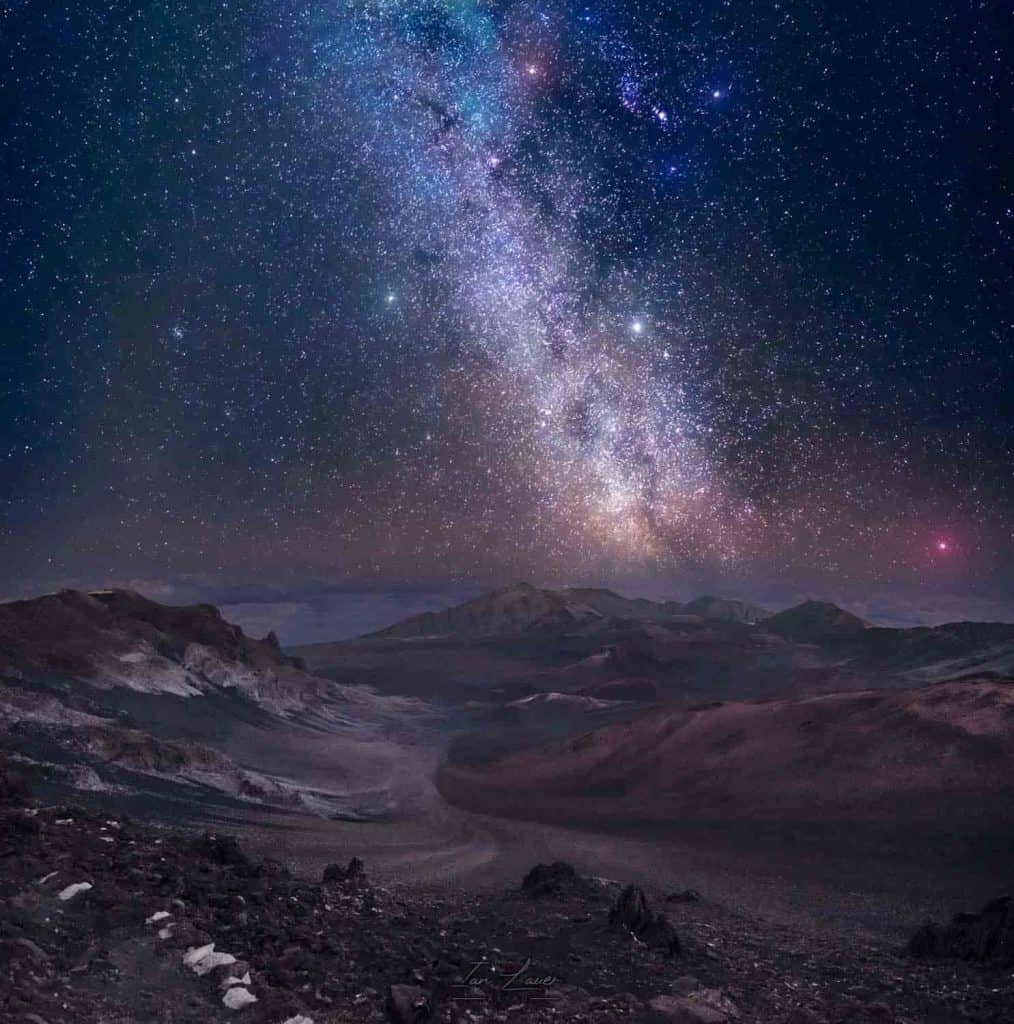
The beauty behind these limited time stores is that you can take it a step further and only have a limited number of items available. This again increases the sense of urgency for the people who have been following you along on your journey. The other aspect of it is that when you do these pop-up stores, it gives you the availability to focus on your work in the next months. You have this spike of income from when people purchased your work and now you can just go back to just focusing on doing your very best at your craft whether it’s photography, digital art, painting or anything else so you don’t have to continually think about selling your work. You give yourself some wiggle room when you do these pop-up stores. I think that’s really helpful because if you are continually stressing about money, it’s going to affect your work.
Stuart: I think that ability to be able to focus on one thing at a time and follow through on that, you do so much better. It is kind of hard to get into the depth of something if you don’t have enough time for it.
How do you keep these sales differentiated and fresh when you do them periodically? Do you have a theme around it?
Ian: It’s all space work so it would seem like every-time you’re selling it’s the same. You also improve as an artist, as a creative every time you do these stores. This is a huge difference. You have a new way of thinking about things. You have a new approach. You have given yourself this time to try a brand new process and so that itself gives you a differentiator between your last launch and your upcoming launch.
A lot of questions people ask is why somebody who bought last time would wanna buy again. You would be surprised at how many repeat customers you have. And also word of mouth. The people who bought from you would also want their friends to buy from you. They are your supporters. They want to see you succeed.
Stuart: You mentioned earlier about building email lists. Emails are a fantastic thing for e-commerce. As you build that list, what kind of percentage do you see who buys your print multiple times?
Ian: A lot. More than 50%. I did not expect that! I just knew that email lists are very powerful and they’re a way to get around the social media algorithm so anything I wanted to communicate, I could send an email to my email list. It’s never gonna be 100% but you would be blown away by how many people become repeat purchasers.
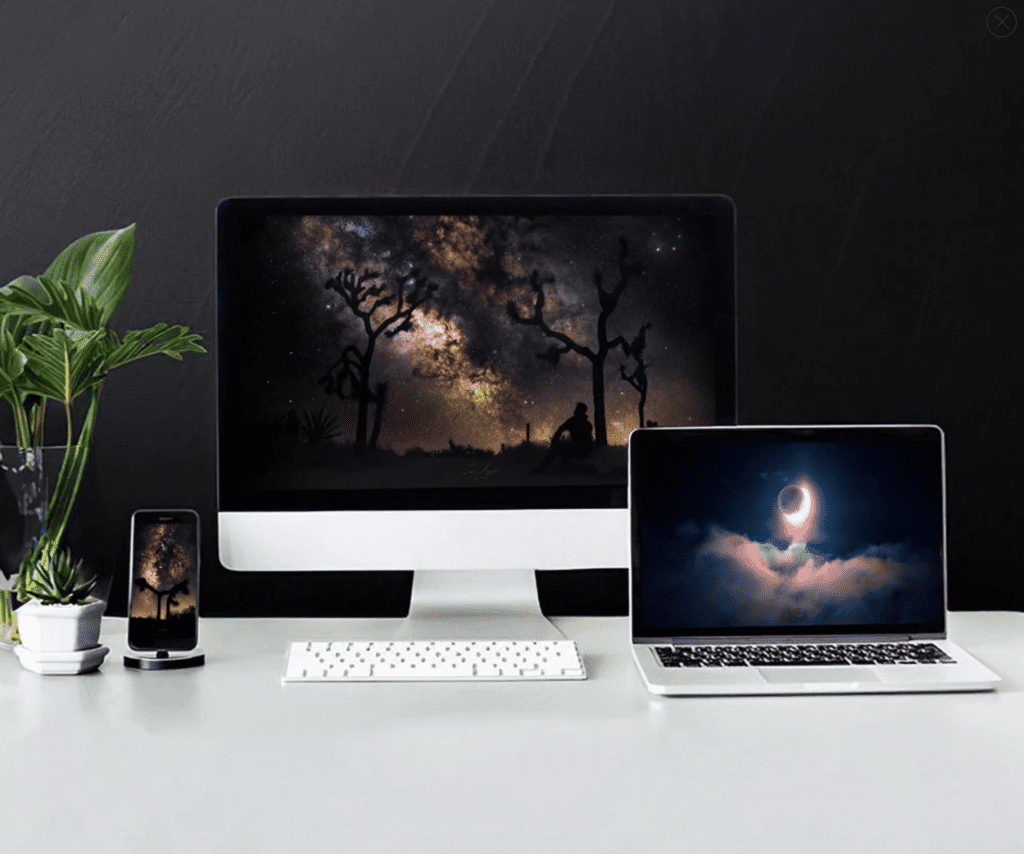
I am a huge advocate of making something available in a store that you’re launching which isn’t always a physical product, maybe some kind of a digital product like wallpapers. Everyone wants to support you but not everybody might wanna buy a print. Digital products are a great way to do that like ebooks, wallpapers, presets etc.
Stuart: That’s a really interesting point. I don’t think we have ever had this many opportunities to focus on different aspects. Screensavers are a fantastic way to get somebody to remember you and engage with you.
Ian: The number of times they see you in a day, that’s just a great way to get them interested in your work. If you build an email list prior to your store launch, you go directly to people’s inboxes and can circumnavigate the social media algorithm. A good way to get people to sign up to your email lists is to be honest and tell them to get notified when the store goes live. The other way is to incentivise people and give them something of value in exchange for their email, like a wallpaper.
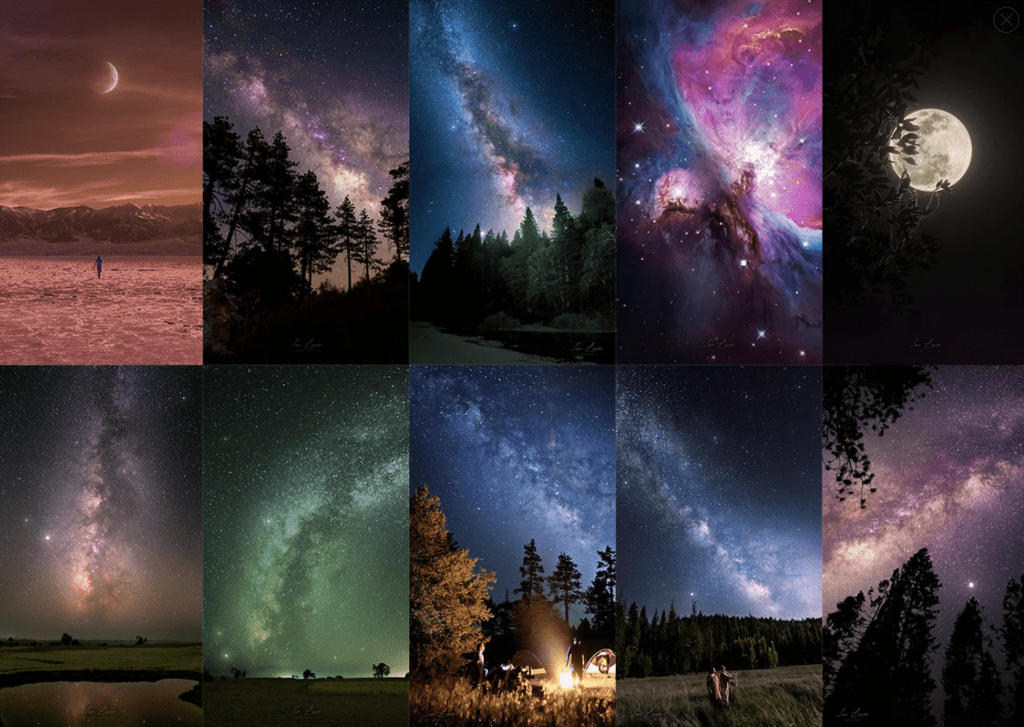
Stuart: What would you say to someone who is starting their journey now? What kind of advice would you give to them to sort of be able to put themselves in a similar position?
Ian: First and foremost I would say, build a community. That’s the most powerful thing. Connect with other artists. Connect with people that you follow. Building a social media presence is probably the most powerful thing you can do as a creative because it allows you access to the entire world. You are no longer limited by your location in this modern day and age. You never know what can happen when you show people who you are. Be the best version of yourself that you can be.
Don’t look at your number of followers as a demotivator for success. Don’t think I only have 10 people on my mailing list. Imagine you are in a room with those 10 and you can communicate directly with them. Next time you gather it’s 20, then 100. That’s quite a lot of people, right?
It’s a powerful thing to have a social media presence, even if it is only 100 people. So it’s not about how many followers you have, it’s what you do with your audience that counts. Truly engage, create those connections and remember, we all start from zero.
